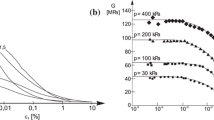Abstract
When a cut slope in a saturated clay is undertaken, a transient water flow occurs and stress transferences from the water to the soil skeleton take place in time (consolidation). Mainly in strongly overconsolidated clays, these stress transferences may determine swelling of soil and therefore reduction of its shear strength in time. However, the lowering of the water level associated to the cut increases effective mean stress, which may therefore counterbalance the above-mentioned effect. In the paper, the behaviour of a cut slope in an overconsolidated clay is analysed by a finite element program that incorporates the Biot consolidation theory (coupled analysis), with constitutive relations simulated by the p–q–θ critical state model. In addition, the variation in time of the overall stability is assessed with a computer program that uses the finite element results and formulations of the critical state soil mechanics. In order to achieve a more complex geotechnical interpretation of the problem, the analysis in time of the excess pore pressures, effective stresses, displacements and stress levels is also presented. Finally, comparisons of stability results are analysed by changing some parameters, namely the problem geometry (weight of excavated soil) and the over-consolidation ratio of the clay.
















Similar content being viewed by others
References
Basset RH (1986a) The instrumentation of the trial embankment and of the Tensar SR2 grid. In: Proceedings of the prediction symposium on a reinforced embankment on soft ground, King’s College, London
Basset RH (1986b) Presentation of instrumentation data. In: Proceedings of the prediction symposium on a reinforced embankment on soft ground, King’s College, London
Borges JL (1995) Geosynthetic-reinforced embankments on soft soils. Analysis and design. PhD Thesis in Civil Engineering, Faculty of Engineering, University of Porto, Portugal (in Portuguese)
Borges JL (2004) Three-dimensional analysis of embankments on soft soils incorporating vertical drains by finite element method. Comput Geotech 31(8):665–676 (Elsevier)
Borges JL, Cardoso AS (1998) Numerical simulation of the p–q–θ critical state model in embankments on soft soils Geotecnia, J Port Geotech Soc 84:39–63 (in Portuguese)
Borges JL, Cardoso AS (2000) Numerical simulation of the consolidation processes in embankments on soft soils. Geotecnia, J Port Geotech Soc 89:57–75 (in Portuguese)
Borges JL, Cardoso AS (2001) Structural behaviour and parametric study of reinforced embankments on soft clays. Comput Geotechnics 28(3):209–233 (Elsevier)
Borges JL, Cardoso AS (2002) Overall stability of geosynthetic-reinforced embankments on soft soils. Geotext Geomembranes 20(6):395–421
Britto AM, Gunn MJ (1987) Critical soil mechanics via finite elements. Ellis Horwood Limited, England
Costa PA (2005) Braced excavations in soft clayey soils—behavior analysis including the consolidation effects. MSc Thesis, Faculty of Engineering, University of Porto, Portugal (in Portuguese)
Domingues TS (2006) Foundation reinforcement with stone columns in embankments on soft soils—analysis and design. MSc Thesis, Faculty of Engineering, University of Porto, Portugal (in Portuguese)
Lambe TW, Whitman RV (1969) Soil mechanics. John Wiley and Sons, Inc., New York
Lewis RW, Schrefler BA (1987) The finite element method in the deformation and consolidation of porous media. John Wiley and Sons, Inc., New York
Mita KA, Dasari GR, Lo KW (2004) Performance of a three-dimensional Hvorslev-Modified Cam Clay model for overconsolidated clay. Int J Geomech, ASCE 4(4):296–309
Potts DM, Zdravkovic L (1999) Finite element analysis in geotechnical engineering—theory. Thomas Telford, London
Potts DM, Kovacevic N, Vaughen PR (1997) Delayed collapse of cut slopes in stiff clay. Géotechnique 47(5):953–982
Quaresma MG (1992) Behaviour and modelling of an embankment over soft soils reinforced by geotextile. PhD Thesis, Universite Joseph Fourier, Grenoble I (in French)
Yeo KC (1986) Simplified foundation data to predictors. Proceedings of the prediction symposium on a reinforced embankment on soft ground, King’s College, London
Author information
Authors and Affiliations
Corresponding author
Rights and permissions
About this article
Cite this article
Borges, J.L. Cut Slopes in Clayey Soils: Consolidation and Overall Stability by Finite Element Method. Geotech Geol Eng 26, 479–491 (2008). https://doi.org/10.1007/s10706-008-9182-7
Received:
Accepted:
Published:
Issue Date:
DOI: https://doi.org/10.1007/s10706-008-9182-7




